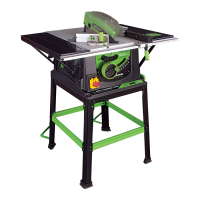
Do you have a question about the Evolution FURY5 and is the answer not in the manual?
| Blade Diameter | 255 mm |
|---|---|
| Motor Power | 1500 W |
| Bevel Capacity | 45° |
| Bore | 25.4 mm |
| Mild Steel Plate Thickness (Max.) | 6 mm |
| Motor (230V~50 Hz) | 1500 W |
| Voltage | 230 V |
| Frequency | 50 Hz |
Details maximum cutting depths and material thicknesses.
Lists electrical and physical attributes of the machine.
Details the diameter, bore, teeth, and kerf of the saw blade.
Provides sound pressure, sound power, and vibration level measurements.
Defines the proper applications and materials the tool is designed for.
Lists specific uses and actions that are forbidden for the tool.
Covers plug, cord, and RCD requirements for safe electrical operation.
Details safety measures when using the tool outdoors.
Comprehensive safety rules applicable to all power tools.
Emphasizes staying alert, using PPE, and preventing unintentional starts.
Guides on proper tool usage, maintenance, and storage for safety.
Stresses the importance of qualified servicing with identical replacement parts.
Warns about harmful dust, lead paint, and recommends protective equipment.
Provides safety rules specific to table saw operation and blade selection.
Warns that freehand cutting is a major cause of accidents.
Emphasizes using the blade guard and maintaining the riving knife.
Covers correct workpiece handling, power cord safety, and tool maintenance.
Lists all accessories and components included with the machine.
Information on optional accessories available for purchase.
Lists and describes the numbered components of the machine.
Details the different types of fixings and parts for the machine stand.
Describes table extensions, support struts, and other miscellaneous parts.
Instructions for attaching the rubber feet to the stand legs.
Steps for connecting cross-pieces to legs to form stand sides.
Procedure for connecting the two stand sides to form the base.
Attaching cantilever braces for added stability and safety.
Instructions for securing the main saw body to the assembled stand.
Steps for fitting table extensions and bracing struts to the machine.
Guide to attaching the rip fence guide and faceplate.
Steps for connecting the two-piece fence rail.
Locating and aligning the rip fence with the saw blade scale.
Ensuring the rip fence is parallel to the saw blade for accurate cuts.
Instructions for fitting and adjusting the sliding mitre gauge.
Guidance on fitting and adjusting the anti-bounce device for specific cuts.
Steps for correctly fitting the top blade guard to the riving knife.
How to start and stop the machine using the safety switch.
Using the handle to adjust the saw blade height.
Adjusting the blade tilt angle for bevel cuts.
Positioning and locking the rip fence for cutting.
Adjusting the rip fence position for optimal cutting alignment.
Using the mitre gauge for angled cuts on either side of the table.
Fine-tuning the anti-bounce device for specific cutting needs.
Setting the correct blade protrusion through the material.
Performing straight cuts across the width of material.
Making angled cuts across the width of material.
Performing crosscuts with the blade tilted at an angle.
Combining mitre and bevel cuts for complex angled cuts.
Cutting multiple pieces to the same length efficiently.
Cutting along the length of material using the rip fence.
Performing angled cuts along the length of material.
Step-by-step guide for safely replacing the saw blade.
Instructions for cleaning the machine after each use.
Explains the function of the riving knife and its maintenance.
Guidance on using and storing the provided push stick.
Facility for storing spare saw blades at the rear of the machine.